How AM/FM Radio, Podcast, And Streaming Audio Ads Can Launch Movie Theatrical Releases And Drive Streaming Video Subscriptions
Click here to view a 19-minute video of the key findings.
Click here to download a PDF of the deck.
A series of new studies reveals a little used marketing platform, audio, could significantly power movie launches and streaming video subscriptions. Streaming music, podcasts, and AM/FM radio can dramatically grow reach and sell movie tickets and video subscriptions.
The new studies include:
- Focaldata: An AI-led online focus group of movie ad creative
- Maru: Study of moviegoers
- Veritonic: Audio creative studies of movie ads
- Nielsen Media Impact: Media plan optimizations
- Edison Research “Share of Ear”: New entertainment audience segments
Key ad creative findings:
- Numerous studies smash the myths that “sight, sound, and motion” are superior to audio ads and that visual media require visual ads.
- Audio ads can be optimized with a less aggressive approach and slower narration. Ensure music and sound effects are in the background and don’t overwhelm the narrator.
- Storytelling works. Have the narrator explain the plot and name the actors rather than using hard to understand, noisy clips from the movie.
Key marketing optimization findings:
- Audio listeners are voracious consumers of movies in the theater and films on streaming services. They are first to see a movie in the theater on opening weekend and when films debut on streaming services.
- Versus linear TV viewers, audio listeners are far more likely to see movies in the theater and indicate a greater willingness to watch content.
- Linear TV advertising spend for theatrical releases and video streaming brands is 30X audio. Despite this, TV viewers show low awareness of new films and low interest in upcoming films and streaming service subscriptions.
- Audio (AM/FM radio, streaming audio, and podcasts) should become a much greater allocation in the entertainment marketing media plan.
- Reallocating 20% of linear TV theatrical and streaming video media plans to AM/FM radio doubles campaign reach with no additional cost.
Ad-supported audio generates the greatest reach among heavy moviegoers; Heavy audio listeners over-index on frequent movie-going, especially for opening weekend
Maru reports 93% of frequent moviegoers, those who watch movies at a theater at least several times a month, are reached by ad-supported audio (podcasts, AM/FM radio, ad-supported music streaming). Ad-supported audio outreaches social media, linear TV, and video streaming among heavy moviegoers.
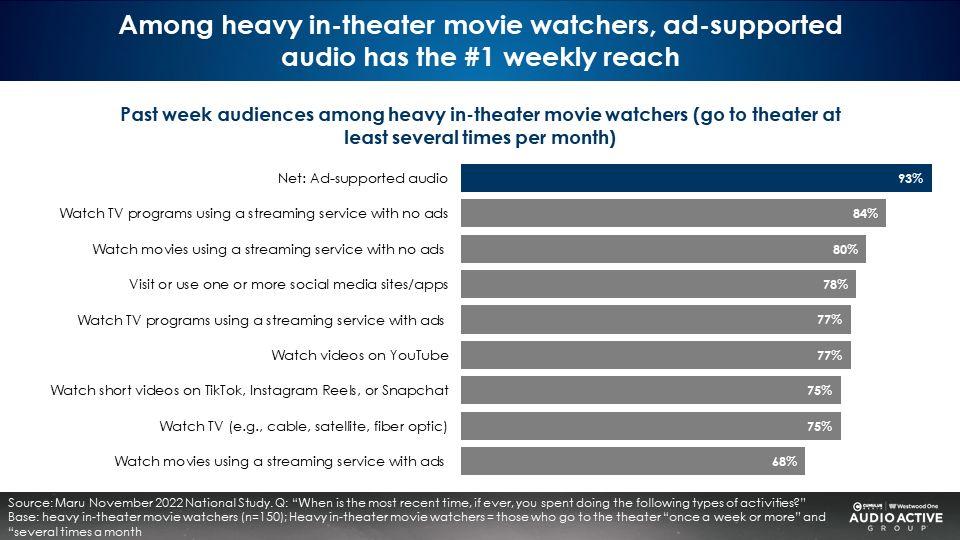
Heavy ad-supported audio listeners are much more likely to be frequent moviegoers. Interestingly, linear TV, a heavily used platform in movie marketing, under-indexes for moviegoing.
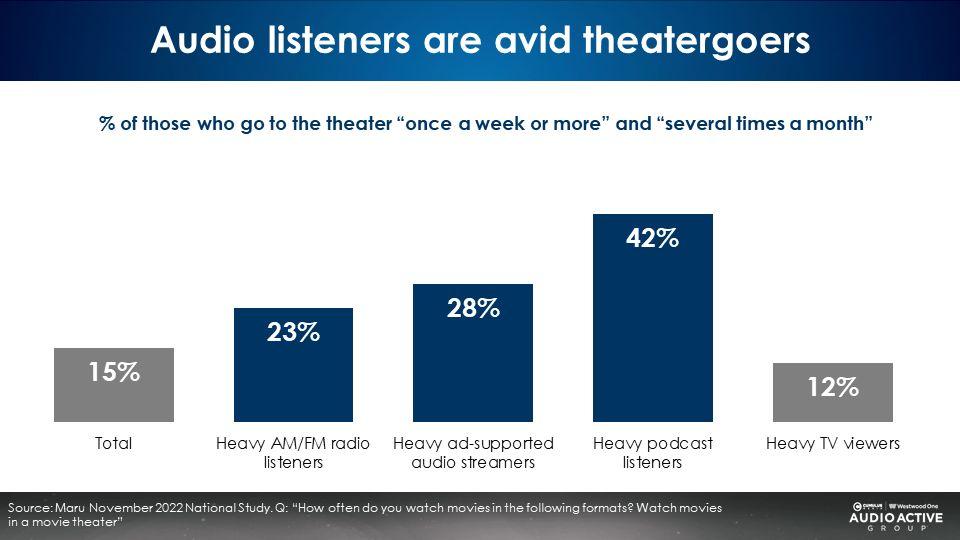
Audio listeners are much more likely to see movies on opening weekend. Linear TV under-indexes.
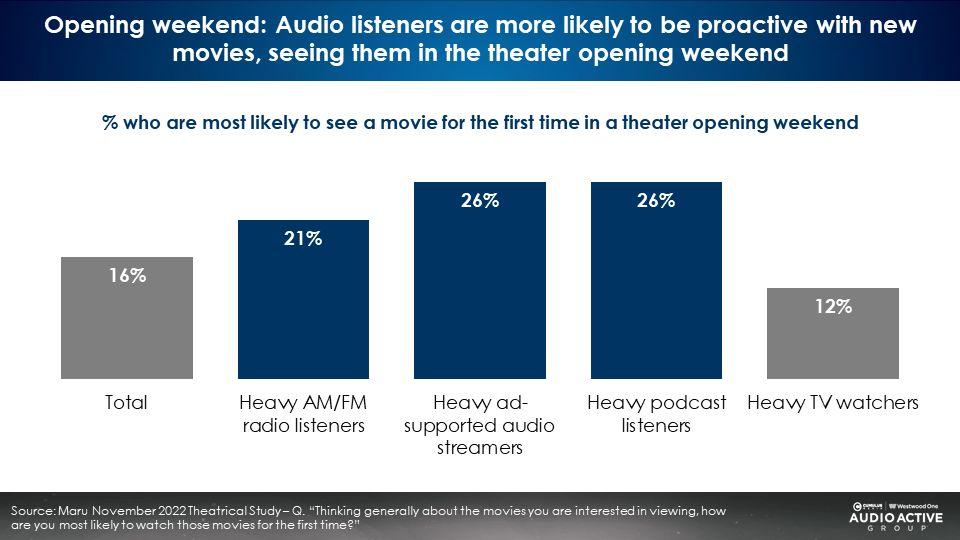
Heavy audio listeners are more aware of upcoming movie releases and more likely to watch in-theater
Maru probed consumers on ten upcoming movie releases. When asked if they’ve heard of the movie, heavy audio consumers (podcasts, music streaming, and AM/FM radio) had greater title awareness compared to heavy social media users and heavy TV viewers.
Audio listeners also lead in intention to see the upcoming releases. Heavy audio listeners show greater in-theater intention compared to social media users and heavy TV viewers.
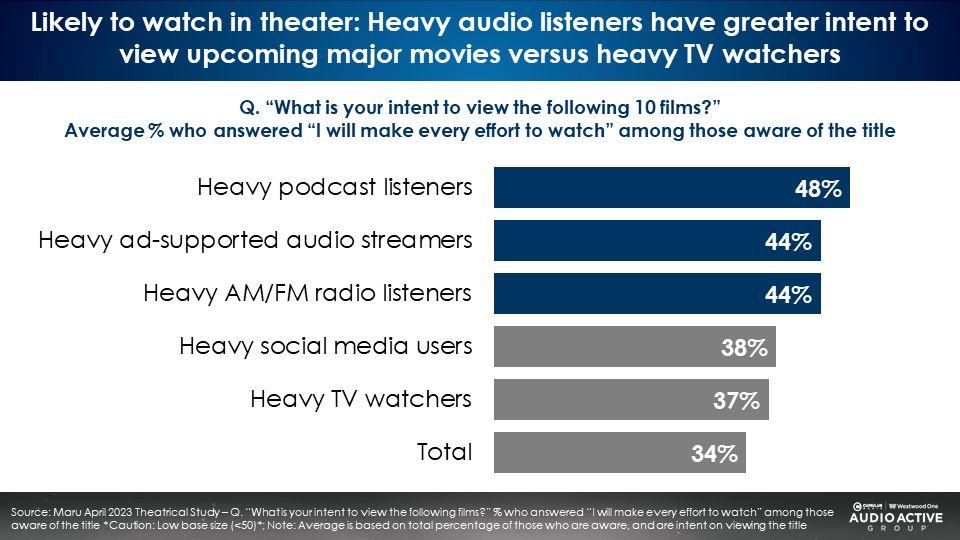
Movie franchises: Heavy audio listeners show the greatest fandom versus social media and linear TV
Maru tested consumers on the appeal of 13 major movie franchises. Audio listeners exhibit the strongest passion and appeal (“I’m a big fan”) compared to heavy social media users and heavy linear TV viewers.
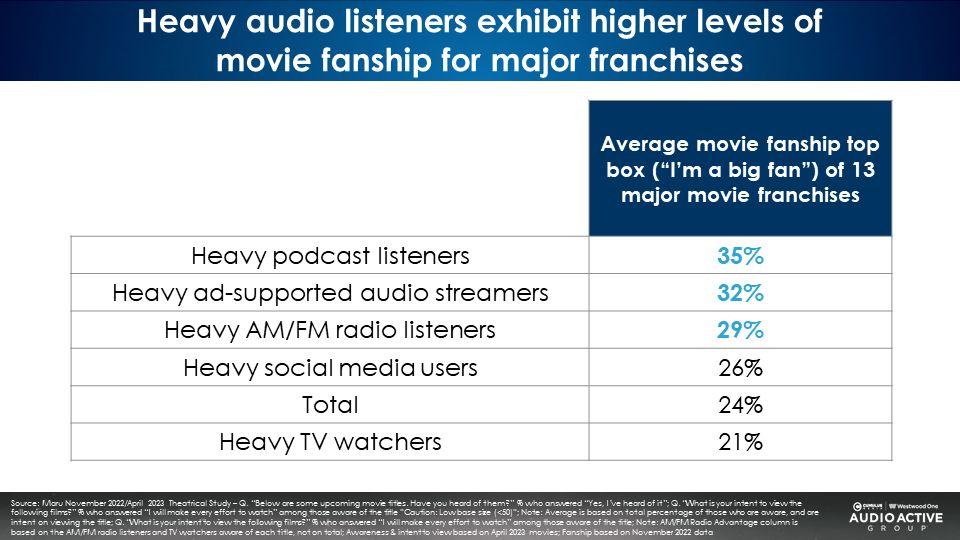
Ad-supported audio generates the greatest reach among heavy streaming movie viewers; Heavy audio listeners over-index on frequent movie viewing and watch titles immediately after release
Heavy streaming movie viewers are those who watch a movie on streaming services at least once a week. Just as with theatrical releases, audio listeners over-index on streaming movie viewing and watching films immediately upon release. From a reach perspective, heavy ad-supported audio listeners are number one in reach among frequent streaming video movie watchers.
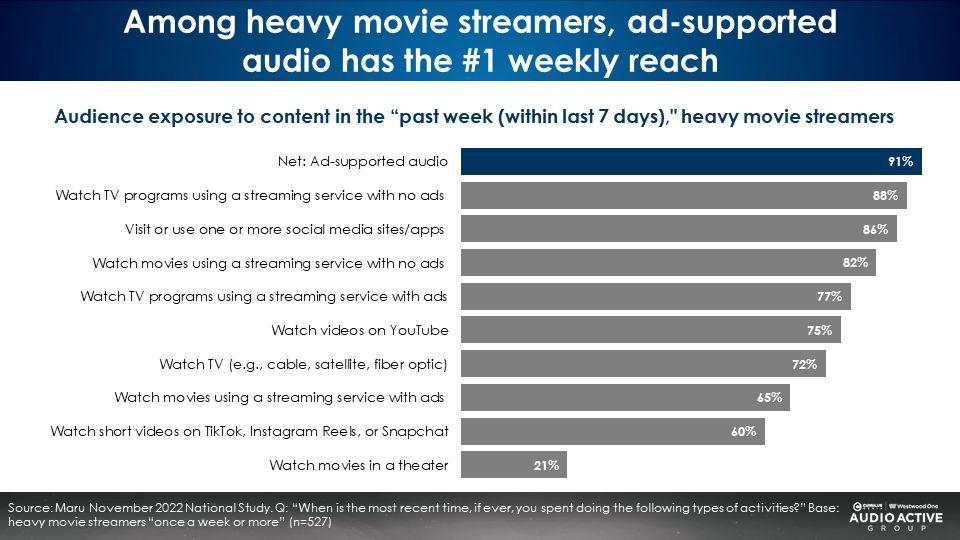
Edison Research’s “Share of Ear”: AM/FM radio leads in audience share among heavy in-theater moviegoers and heavy streaming movie viewers
Edison Research’s quarterly “Share of Ear” study is the authoritative examination of time spent with audio in America. Recently Edison introduced two new segments to their reporting: heavy in-theater moviegoers and heavy streaming movie viewers. In both cases, AM/FM radio leads in ad-supported audio shares, followed by podcasts.
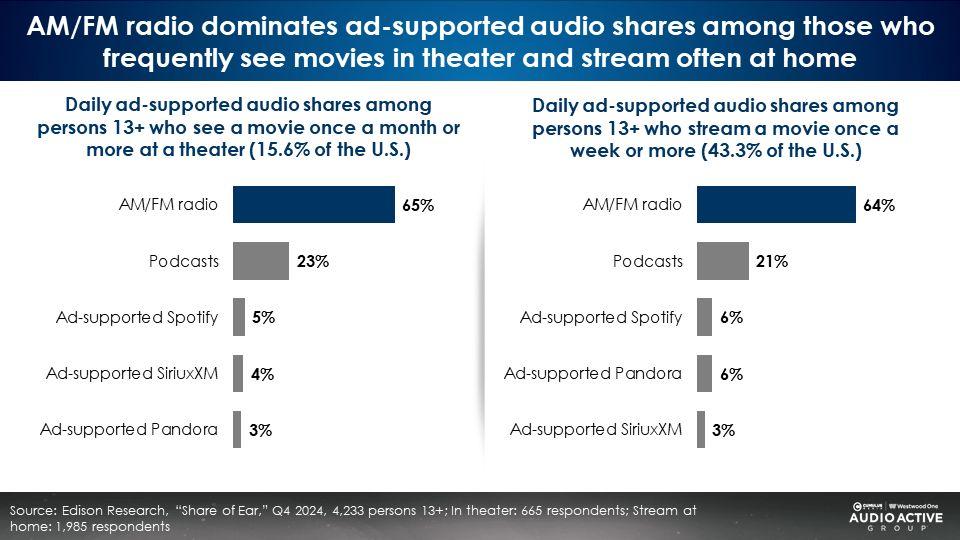
Vivvix: Entertainment marketing media plans primarily utilize linear TV and digital with little use of audio
A Vivvix tally of movie media spend for 2024 reveals two-thirds of all media budgets are devoted to linear television, followed by digital. Streaming service media plans devote equal proportions of ad spend to digital and linear TV. Audio use is negligible.
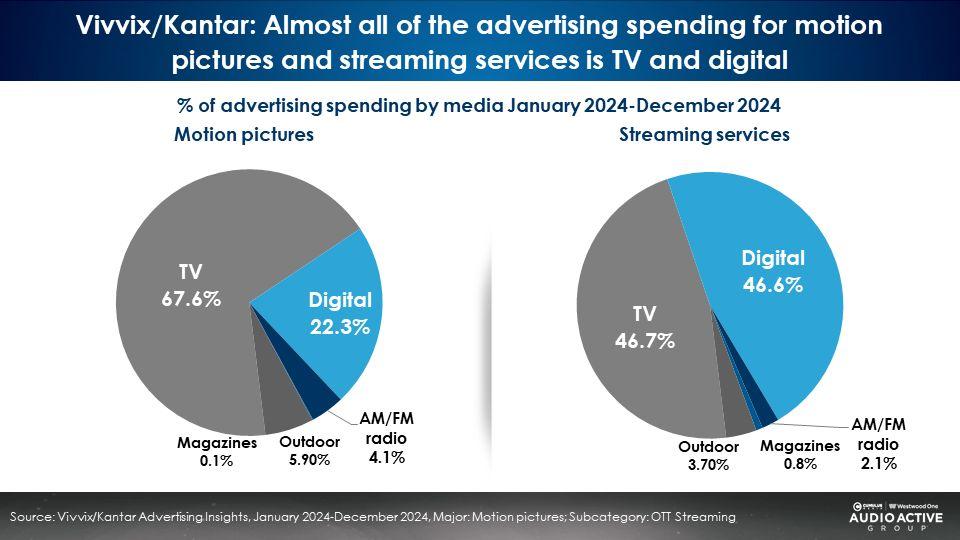
Could the introduction of audio into the media plan lift campaign reach?
Nielsen Media Impact: Shifting 20% of movie marketing budgets to audio generates a massive increase in campaign effect and reach
Nielsen examined five recent movie TV campaigns and determined the reach among persons 18-49. While the linear TV budgets varied, the greatest campaign reach was in the mid- or upper-30s. The vast majority of America (60% to 75%) never saw the linear TV campaigns for these films.
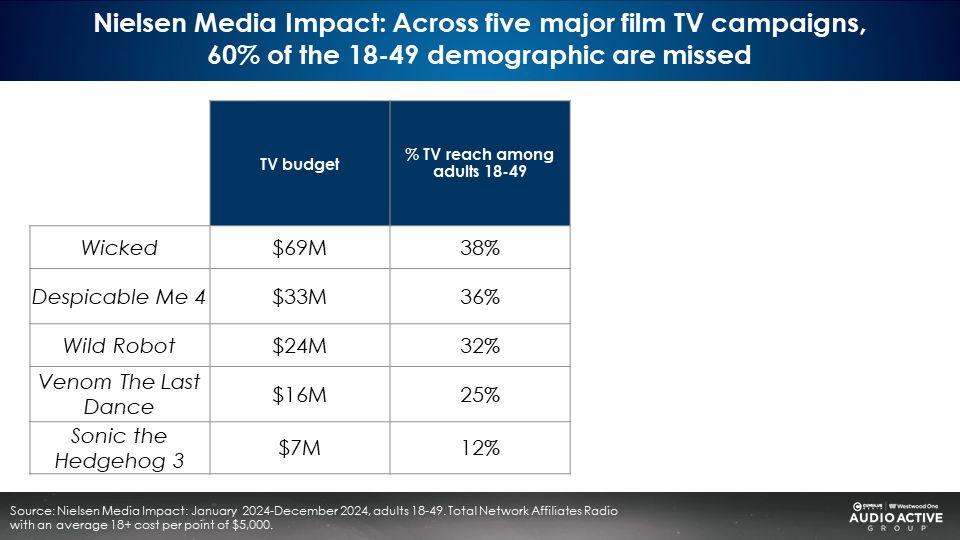
What happens if 20% of the linear TV campaign budget is shifted to AM/FM radio? Campaign reach doubles! Smaller TV campaigns see even greater reach growth.
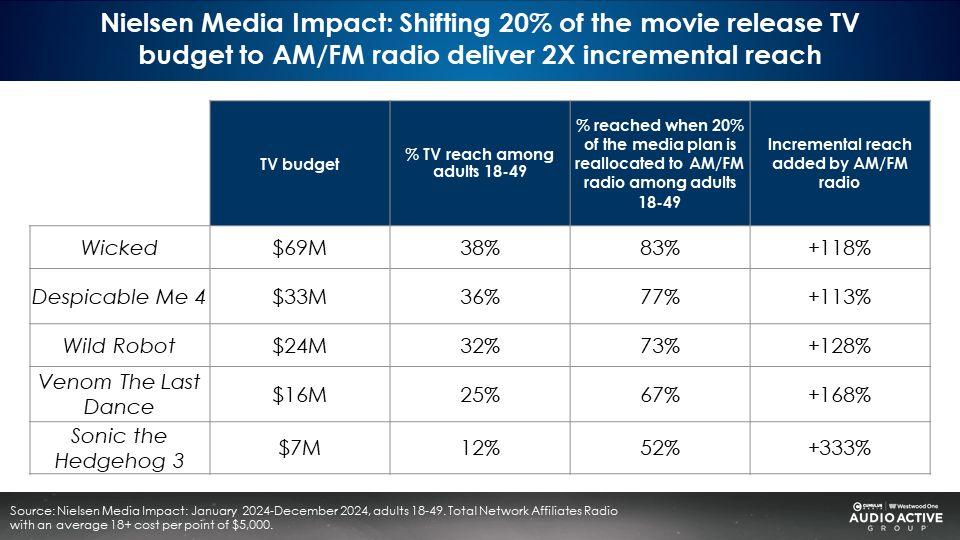
Shifting 20% of Wicked’s linear TV budget to AM/FM radio would cause reach to surge from 38% to 83%, a 2X incremental reach lift with no budget increase. Reallocating 20% of Sonic the Hedgehog 3’s linear TV media plan to AM/FM radio generates a 4X increase in reach.
Can AM/FM radio elevate the streaming video media plan? Hulu’s TV deliveries and an AM/FM radio reallocation scenario say yes
Nielsen studied a recent linear TV campaign from July 2024 for Hulu, which generated a 34% reach among 18-49s. What happens if 20% of the TV budget is shifted to AM/FM radio? Reach soars by +76% with no budget increase.
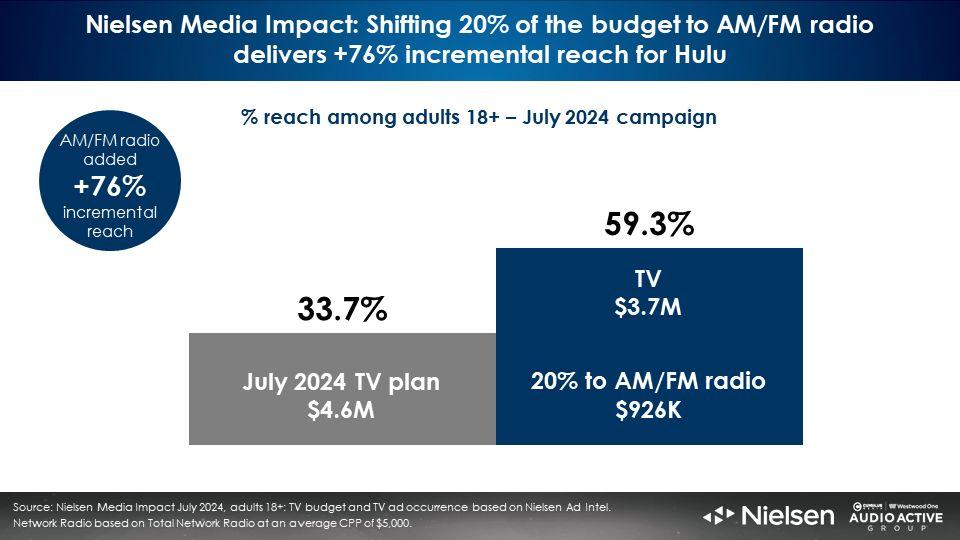
AM/FM radio makes your TV better by lifting reach among younger demographics
Since 80% of linear TV time spent occurs among viewers over the age 50, it’s not surprising that TV reach deliveries skew older. Here’s reach by demographic for Hulu’s July 2024 TV campaign:
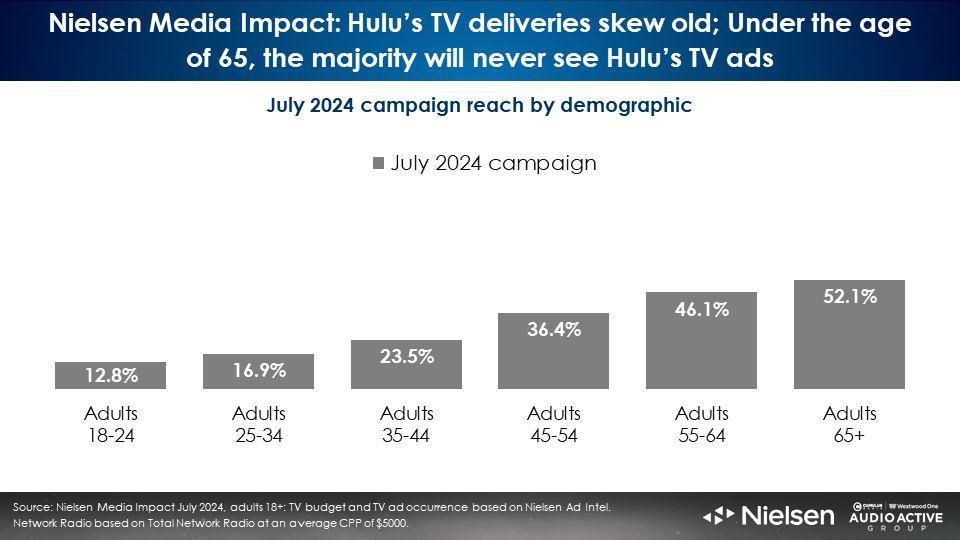
While Hulu’s linear TV campaign reaches half of those 65+, reach is sharply lower under the age of 50. What would happen to Hulu’s younger demo reach if AM/FM radio is introduced into media plan? Massive lifts in 18-54 reach! The grey bars below represent the original Hulu TV buy. The blue bars represent the 80% TV/20% AM/FM radio reallocation scenario.

Shifting 20% of the linear TV budget to AM/FM radio causes 18-34 reach to 3X. 35-44 reach grows over 2X.
AM/FM radio’s superpower is lifting reach deliveries among light and medium TV viewers
The grey bars below depict Hulu’s reach delivery among light, medium, and heavy TV viewers. While Hulu’s campaign reaches two-thirds of heavy TV viewers, the campaign misses two-thirds of medium TV viewers and 85% of light TV viewers. A wise media planner once said, “You cannot solve the light TV viewing problem by buying more TV.”
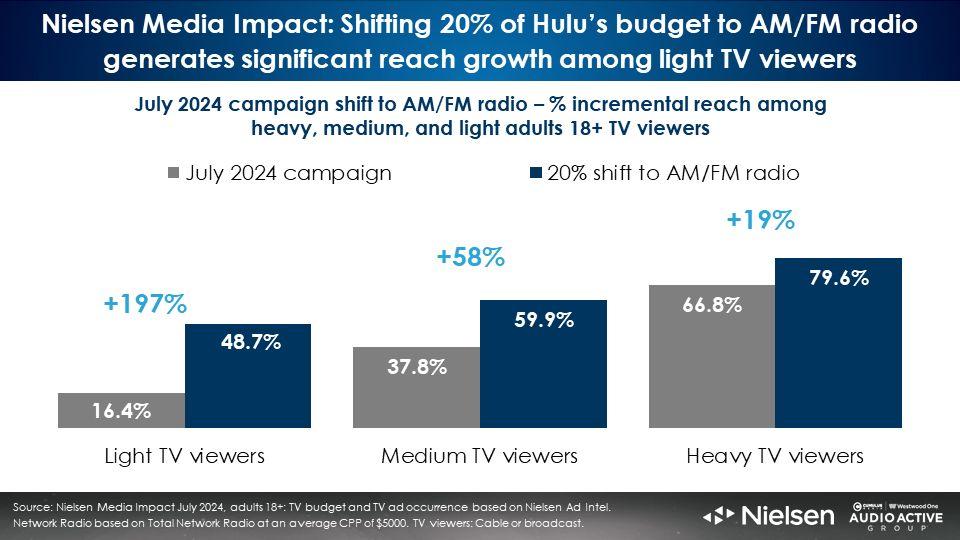
AM/FM radio to the rescue. Shifting 20% of the linear TV plan to AM/FM radio generates an eye-popping 3X increase in light TV viewer reach and a 58% increase in medium TV viewer reach.
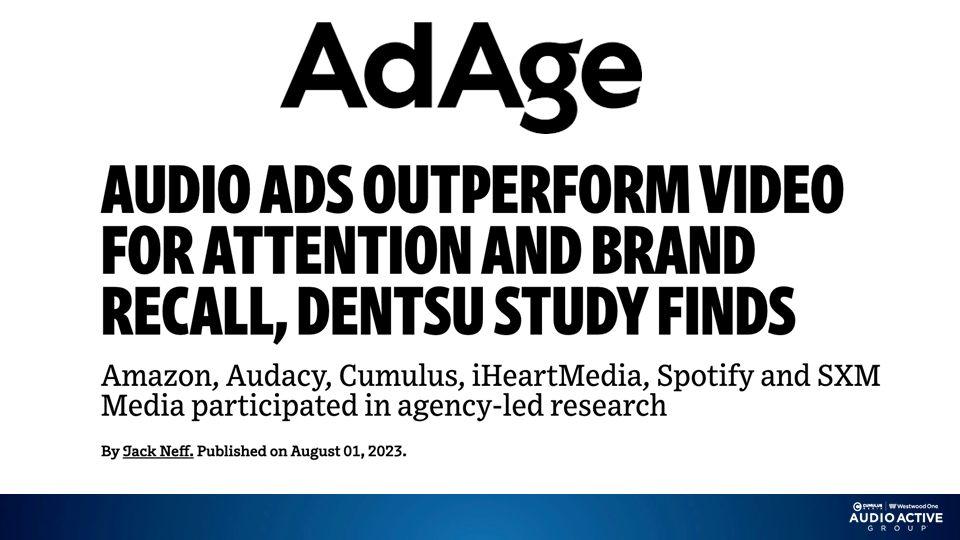
Lumen reports that consumers often look away from video screens but cannot shut their ears. As such, Lumen found audio ads outperform video for attention and brand recall.
Audio creative optimization: Veritonic creative testing reveals plot-driven ads outperform mood driven ads
Veritonic tested movie viewing intention for ads that established the mood of the film versus ads that explained the plot of the film. Plot-driven ads drive 2X the viewing intention of mood driven ads.
Focaldata: Fast-talking and noisy ads destroy audio creative effectiveness
Focaldata, a leader in AI-powered online focus groups, tested audio ads for Disney, which touted a Disney+ bundle among podcast listeners. Respondents found the fast-talking narrator jarring and the pounding music competed with the narrator’s voice, making the ad hard to understand.
Focaldata found plot-driven ads for the Netflix series Luther were very well-received and piqued curiosity and interest in the series. The lack of clips from the series was viewed positively. Consumers appreciated the narrator’s explanation of the plot and storytelling aspect of the ad.
Entertainment ads should slow down and not rush. Again, there were audience concerns expressed over the pace of the ad. Many noted the ad was “spoken too fast.”
Key ad creative findings:
- Numerous studies smash the myths that “sight, sound, and motion” are superior to audio ads and that visual media require visual ads.
- Audio ads can be optimized with a less aggressive approach and slower narration. Ensure music and sound effects are in the background and don’t overwhelm the narrator.
- Storytelling works. Have the narrator explain the plot and name the actors rather than using hard to understand, noisy clips from the movie.
Key marketing optimization findings:
- Audio listeners are voracious consumers of movies in the theater and films on streaming services. They are first to see a movie in the theater on opening weekend and when films debut on streaming services.
- Versus linear TV viewers, audio listeners are far more likely to see movies in the theater and indicate a greater willingness to watch content.
- Linear TV advertising spend for theatrical releases and video streaming brands is 30X audio. Despite this, TV viewers show low awareness of new films and low interest in upcoming films and streaming service subscriptions.
- Audio (AM/FM radio, streaming audio, and podcasts) should become a much greater allocation in the entertainment marketing media plan.
- Reallocating 20% of linear TV theatrical and streaming video media plans to AM/FM radio doubles campaign reach with no additional cost.
Click here to view a 19-minute video of the key findings.
Pierre Bouvard is Chief Insights Officer of the Cumulus Media | Westwood One Audio Active Group®.
Contact the Insights team at CorpMarketing@westwoodone.com.